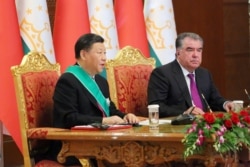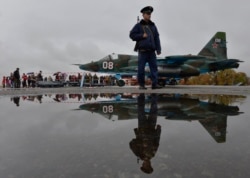China is steadily increasing its security footprint in Central Asia and closing the gap with Russia, a trend that could see Moscow’s influence “undermined in the coming decade,” according to a new report.
Beijing is muscling in on the former Soviet republics in its neighborhood -- traditionally part of Moscow's "near abroad" -- through increased arms sales, training programs, and new military outposts, says a report released on May 27 by the Wilson Center’s Kennan Institute, a Washington-based think tank.
Since the collapse of the Soviet Union, Russia maintained its edge as the region’s main security guarantor, even while the Kremlin has come to accept China’s economic supremacy in Central Asia.
China is already a hard power in the region.”-- Bradley Jardine, Wilson Center
This has led many commentators to describe Beijing and Moscow’s dynamic in the region as a division of labor, where Russia shapes Central Asia through its political and military ties and China works as a creditor and driver of economic growth, particularly through its multibillion-dollar Belt and Road Initiative.
The report’s authors, however, find that China has made “significant inroads in the security sector” in recent years, disrupting this separation of powers between the two countries in the process and setting the stage for increased friction in the future.
“We keep talking about this notion that there is a strict division in Central Asia where Russia deals with security and China does economics, but actually that division is fading,” Bradley Jardine, the report’s lead author and a fellow at the Wilson Center’s Kissinger Institute on China and the United States, told RFE/RL. “China is already a hard power in the region.”
This shift can be seen in Chinese arms sales to Central Asian governments, with Beijing accounting for 18 percent of the region’s military hardware over the past five years, a dramatic increase from the tiny 1.5 percent of Central Asian arms it provided from 2010 to 2014, the report says.
These sales have ranged from weapons and transport vehicles to high-tech hardware such as armed drones, a highly sought after global market traditionally cornered by the United States and Israel.
China has also constructed its first military facilities in the region, building up a small but growing security presence in Tajikistan, which shares an 1,356-kilometer southern border with Afghanistan and a 476-kilometer eastern border with China.
A 2019 report from The Washington Post found a small collection of Chinese military compounds, along with Chinese personnel, in Tajikistan. A Wall Street Journal article from the same year cited sources who referenced a secret agreement between China and Tajikistan where Beijing was granted rights “to refurbish or build up to 30 to 40 guard posts on the Tajik side of the country’s border with Afghanistan.”
Beijing also increasingly seeks to safeguard its infrastructure investments in Central Asia by expanding its security footprint.
Russia’s arms sales to the region have hovered consistently around 60 percent for several years, meaning that China’s growth has thus far not come at the expense of Russia’s market share. But that could change in the coming years, according to the report.
“Lots of people talk about China and Russia competing already, but actually our research shows that the competition hasn't really started yet,” said Jardine. “As China continues to grow as an arms supplier, it will have to eat into Russia’s share and that’s where we can begin to see some tensions between Beijing and Moscow.”
Russia Still Dominant
Russia is still the region’s preeminent external military force and largest arms supplier.
Moscow maintains facilities across Central Asia, including more than 7,000 troops stationed in Tajikistan and an air base in Kyrgyzstan, with the Russia-led Collective Security Treaty Organization being a key venue for ties with regional militaries.
Despite China’s growing role in security, Beijing and Moscow maintain a wider partnership that has grown deeper in recent years and the two share overlapping goals in Central Asia: preventing potential instability coming from Afghanistan and stemming any rise in terrorism and extremism.
Beijing views Central Asia as a buffer against its eastern Xinjiang Uyghur Autonomous Region, where the Chinese government has imprisoned more than 1 million Uyghurs and other Muslim minorities, such as ethnic Kazakhs and Kyrgyz, in internment camps.
China and Russia are also united in their rivalry with the United States.
Both countries have worked to reduce U.S. influence in the region, welcoming the closure of a U.S. air base in Kyrgyzstan in 2014 and its military drawdown in Afghanistan.
Friendly Competitors
But both countries are also increasingly vying for influence with one another in Central Asia.
According to the Kennan Institute report, training programs for Central Asian military officers are increasingly important for both Moscow and Beijing.
As with arm sales, Russia is still the leader in this regard, with strong training links through its military schools to all five Central Asian countries.
But China is looking to catch up.
The Shanghai Cooperation Organization (SCO) -- of which Kazakhstan, Kyrgyzstan, Russia, Tajikistan, and Uzbekistan are all members -- has been an important vehicle for this, with plans for a center to train 2,000 senior officials from SCO countries by June 2021.
Beijing has also moved to train Central Asian military personnel on a bilateral basis. While its numbers still trail those of Russia, both China’s People’s Armed Police (PAP) paramilitary unit and People’s Liberation Army (PLA) academies are training officers from the region, although exact figures are not made public.
Beijing Goes Its Own Way
While both China and Russia rely on a combination of bilateral ties and multilateral organizations, the report notes Beijing is increasingly developing its own initiatives for the region without Moscow.
In 2017, Moscow pushed for India and Pakistan to join the SCO, a move that many observers saw as a way to dilute the organization and check Chinese influence by welcoming in two countries with their own dysfunctional history.
This led Chinese military diplomacy to shift -- to some extent -- to a new organization without Russian participation known as the Quadrilateral Cooperation and Coordination Mechanism (QCCM) where Afghanistan, China, Pakistan, and Tajikistan cooperate on counterterrorism.
Similarly, the PAP has conducted drills and enhanced cooperation with Central Asian national guard units, with Kyrgyzstan, Uzbekistan, and Tajikistan taking part in an exercise in 2019 -- a move that caught Moscow’s attention.
“Russia has cautiously eyed the activities of the PAP and in recent years has promoted its equivalent unit Rosgvardiya as an alternative partner for Tashkent,” the report notes.
While Russian influence and its role in Central Asian security are still strong, China is becoming increasingly active and growing its presence in the region for the decades to come.
“Russia is seen as a declining power in Chinese circles,” said Jardine. “Long term, there is a sense that Beijing needs to prepare for a receding Russia and they are preparing for that now.”









